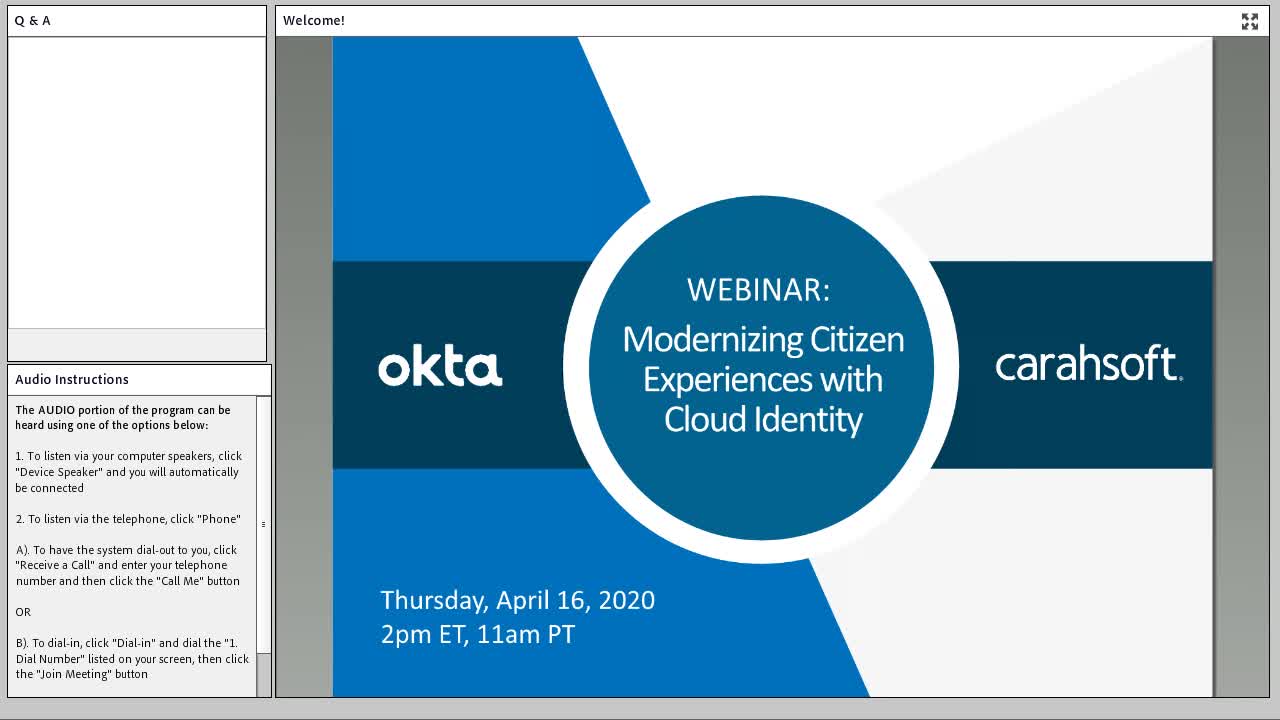Modernizing Government Agencies: Delivering Frictionless Experiences to Citizens, Quickly and Securely
Doing our errands looks a lot different now than it did a few years ago, and not just because of the COVID-19 pandemic (though that has certainly accelerated things). For a while now, we’ve been ordering groceries online, paying bills on a banking app, and even checking in with our doctor from the comfort of home. With so many digital experiences shaping our daily lives—and companies innovating on how they deliver seamless offerings—our expectations around what makes quality service have evolved significantly. But what does that mean for government services?
As government agencies make the ongoing shift toward digital, they have to fulfill their mandates in a way that’s as user-friendly as it is secure—without the in-person safeguards they long depended on. While many institutions use identity and access management (IAM) solutions to secure how employees access resources, they still have a way to go with bringing their citizen services up to date.
Thanks to legacy systems, disparate toolsets, and a lack of cross-agency interoperability, citizen-facing apps are often inflexible and require a sprawl of different login credentials. The result? A frustrating user experience—or worse, a platform that citizens struggle to access at all.
Instead, citizens want their interactions with the public sector to be as frictionless as their experiences with retail and social media apps. In the second part of our “Modernizing Government Agencies” series, we’ll look at how adopting customer identity and access management (CIAM) solutions can help agencies provide more intuitive user experiences and in turn, improve compliance and minimize the cost of maintaining their digital systems.
Reducing friction with modern CIAM
When we talk about user friction, we’re referring to any unnecessary challenges that interrupt the user from accomplishing their goals. Asking users—which for agencies refers to members of the general public—to resubmit information they’ve already given on a separate channel, requiring them to keep track of multiple credential sets for different functions, and failing to optimize apps and websites for different devices all stand in the way of great service. To move beyond these inconveniences, government agencies need to truly know and understand their users.
Simplifying user experiences
With an effective CIAM strategy, agencies can create and maintain a single, secure view of registered users and their profiles. This protects both the agency and the citizen, as it allows institutions to perform identity proofing to validate the user before granting them access to sensitive information. Moreover, with that single view of the citizen, agencies can send well-informed communications, reduce the work it takes to make updates, and even grant access to the resources they need, no matter the device or channel involved in each interaction.
Civilians, employees, contractors, and teams at other agencies use government services for a variety of reasons. Modern CIAM lets agencies customize processes and features to suit the needs of each user type, so whether your user is a citizen applying for official documents or a staff member looking for job-relevant files, each has a convenient path to do the things they need.
Reducing developer efforts
Government bodies are responsible for implementing effective security and usability features without delay. Okta provides developers with the tools to deploy sophisticated solutions with ease, including a range of APIs, SDKs, and extensive documentation and guides. With Okta’s cloud-based CIAM platform, developers can complete and deploy common identity workflows (e.g., registration, account recovery, and forgotten passwords) in minutes, and therefore have more time to focus on addressing the mandates that are unique to their agency.
CIAM in action: CDO Technologies and Okta
As a leading CIAM provider, we’ve worked with many public sector organizations to deliver seamless citizen services.
CDO Technologies, an IT contractor for the U.S. Air Force, had the task of moving the Air Force’s entire Human Resources (A1) data center to the cloud. The A1 data center includes the 33 systems and 200 applications the Air Force needs to manage and communicate with active personnel, reservists, contractors, federal employees, and an extended network of retirees, families, dependents, and volunteers.
Many apps in the Air Force data center were linked to a legacy, on-prem IAM solution, and secured by outdated practices and protocols. For instance, some login credentials were relayed through email, while other account information was siloed in various applications. As user confidence in A1’s systems began to decline, CDO saw the solution: a centralized, cloud-based identity management system, pulling the many disconnected users and applications into a single portfolio where each identity is convenient to manage, audit, and secure.
After reviewing several identity providers for security, user experience, and value, CDO chose to collaborate with Okta. Using Okta, CDO was able to achieve a range of benefits that contribute to frictionless citizen services, including:
- Centralized identity and access management for 5 million users globally
- Simple, streamlined adaptive multi-factor authentication that secures logins for the whole user community
- Custom information access policies that account for the user’s location
- Smart card access for active service members, select civilians, and contractors
- FIPS 140-2 validated encryption to authenticate ancillary and non-active-duty users
- Improved auditing and reporting tools that guarantee security and privacy compliance and provide smarter detection and response to anomalies
The CDO demonstrates that creating seamless citizen experiences, while respecting security and compliance requirements, is feasible for government agencies. In fact, with the right identity platform, it can be easy.
The rest of this series will explore how modern CIAM can help government agencies centralize their access management and build secure, scalable digital experiences for citizens. In the meantime, read our whitepaper to learn more about how CIAM can improve online government services for civilians, employees, and other users.


